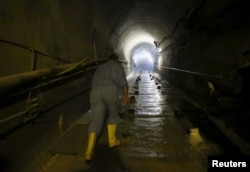After six months of intensified repairs, Iraqi officials claim the massive Mosul Dam has been saved from impending disaster. But experts say it will always be at risk of collapse and will need constant maintenance.
"There remains no danger to the dam now," Hassan Janabi, Iraq's minister of water resources, told VOA. "It is with overwhelming happiness to announce that it is going back to normal operation."
The 13-kilometer-long dam on the Tigris River in northern Iraq is the Middle East's second-largest dam. Concerns over its instability have been persistent since its construction in 1981 — when it was known as the Saddam Dam — due to the fact that it was built on a soft landscape, and there have been continuing questions about shoddy work when it was built.
Located 60 kilometers north of Mosul, the dam received international attention after Islamic State took control of it for several weeks in 2014. After U.S.-backed Kurdish peshmerga forces pushed IS from the dam area, experts warned it was in dire condition and could unleash a trillion-gallon wave of water on 1.5 million people in Iraqi's two largest cities, Mosul and the capital, Baghdad.
'No significant signs of distress'
Italian company Trevi started repairs in October 2016. Carlo Crippa, the project manager, said the dam structure now shows no significant signs of distress. However, constant maintenance will be necessary, as "the rocks of the foundations are prone to dissolution due to the circulation of water."
The five waterways that control the flow of water into the dam are open, after being closed for over 12 years, and Minister Janabi said water levels are now at the highest level since 2005.
Despite these assurances, experts who have studied the dam structure say it remains far from safe.
"There is always a chance that water is going to migrate," said Azzam Alwash, an Iraqi-American civil engineer who has served as an adviser on the dam. He said 24 sinkholes remain in the dam's reservoir, making it vulnerable to pressure from water flows.
"This is a dam tantamount to a nuclear bomb," Alwash said. "Are you going to take the risk of keeping your family in a place where it can sink under as much as 15 meters of water in a matter of hours? I'm not."
More serious risk
Nadhir al-Ansari, professor of water resources and environmental engineering at Lulea University in Sweden and a published expert on the Mosul Dam, agreed that the risk is serious.
"There is no guarantee the dam will ever be safe. Studies done on the dam all show that its collapse is imminent," he said. "The minister may say it's safe because Iraq is already past the flooding season, which peaks in April and ends in May. You will have the same problem every year in April."
To fill the cavities that form underneath the concrete, engineers have injected the dam with more than 50,000 tons of grout, a liquefied mixture of cement and other additives, since it opened in 1986.
"The grouting solution by the Italian company is only a temporary measure for emergency fixes," al Ansari said. "When they block a cavity in one place, it appears in another place. This is something that can't be stopped. … The only solution is to build another [dam] close to it."
Such an effort began in 1988 with the construction of Badush Dam, 12 kilometers away. It was 40 percent complete before work was halted in 1992 due to U.N. sanctions on Iraq.
Apart from building a new water-containment system to relieve the strain on Mosul Dam, Alwash said "the solution is to empty the reservoir." To do that, Iraq would have to reach out to neighbor states upstream on the Tigris River — especially Turkey — to control the influx of water.
"Don't put more money into repairing it," he said. "Put political will to work with neighboring countries on water management."
For now, Janabi said teams of experts will continue to monitor the dam's stability. He said he is confident "in our ability to manage the dam under all difficult circumstances."






